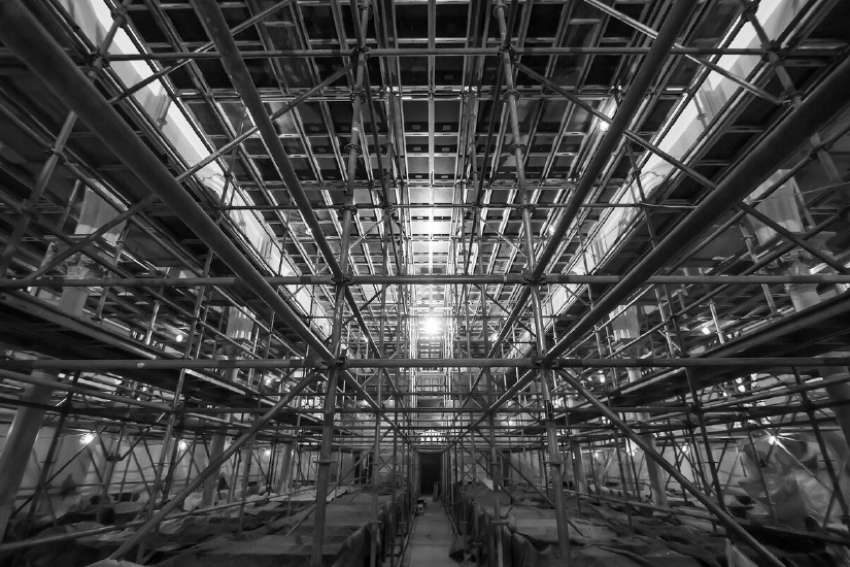We are blessed on Wolfe Island with a magnificent church — more like a cathedral, visitors often say. Dedicated to our Lady under the title of the Sacred Heart of Mary, it was built in 1916-1917, and dedicated in June 1918. I had begun thinking a few years back how to mark the centennial.
I never considered a top-to-bottom repainting of the church interior, matched by a rewiring of all the century-old electrical apparatus. That’s what we did though, and are looking forward to a special centennial Christmas. It wasn’t our plan; Providence had a better one.
The story begins at Midnight Mass last Christmas, a Mass that never was. Upon entering the church I found it filled with smoke due to a small fire in the sacristy. The direct loss due to the fire was minimal, but the smoke damage reached up into the vaulted ceiling. Midnight Mass was cancelled, though after some quick cleaning we were able to continue using the church.
In the months after the fire, our parish — a small congregation with great spirit — decided not to limit ourselves solely to what the insurance claim would cover, but to look at the repair as a providential occasion to enhance the beautiful church we had inherited from previous generations of Wolfe Island Catholics.
We were blessed to find the right team to take on the project, Ecclesiastical Refinishing Group, a local firm of exceptional expertise right in Kingston. I knew their work, for they had completed in recent years three stunning renovations in our area. The proprietor, Mark Gray, and the chief designer, Andrea Belliveau, well understood that a church design must be beautiful — ugly churches are neither pleasing to God nor His people. It is not a sin to worship in an ugly church, but I am quite convinced it is to design one.
More than that though, Mark and Andrea understood that a church design must reflect liturgical theology. I knew that we would work well together when the initial designs began with the principle that the sanctuary ought to be set off from the body of the church, and should be a glimpse of the glory of Heaven. A stunning new gold interior dome accomplishes just that, along with the new sky blue ceiling in the nave that lifts the heart and mind heavenward.
It was a given that our church would maintain its Marian theme, and I wanted to enhance that Marian symbolism. As the months of 2017 passed and we observed the centenary of the apparitions at Fatima, I was struck by the coincidence of dates. The construction of our church — the third one in a parish history dating back to 1847 — began on July 20, 1916. It was that year that the holy children of Fatima were first visited by the angel who taught them about devotion to the Eucharist.
The church construction continued throughout 1917 at the very same time as Our Lady was teaching the little shepherds at Fatima about consecration to her Immaculate Heart. Now in the centennial year of the apparitions, we were renewing the design of our church in time for our own centennial. Sometimes it is not hard to read the designs of Providence.
So I worked with Andrea to make that link more explicit. The old stencilling in the church was replaced with a more ornate stencil that she designed based on the mantle of the statue of Our Lady in Fatima itself. She added crowns throughout the church, giving the sense that Mary’s protection, from crown to the edge of her mantle, covers all of her children. In the crown that appears over our tapestry of St. John Paul the Great, I asked Andrea to add a bullet, recalling the assassin’s bullet that John Paul had placed in the crown of Our Lady’s statue in Fatima.
Over the summer, when our bishops consecrated Canada to the Immaculate Heart of Mary, we learned that the title of our church — Sacred Heart of Mary — was associated with Canada’s founding saint, Bishop François de Laval. The territory of the Archdiocese of Kingston was taken from the Archdiocese of Quebec in 1819. That link to Quebec and St. François was drawn out by the addition of an exquisite fleur-de-lis pattern in our ceiling, a Marian symbol already em ployed in our stained glass windows.
Complementing Ecclesiastical’s brilliant design and gifted artists, we took advantage of the scaffolding in the church to rewire the entire church and shift to a brighter lighting system. Mark noted that it is often only after parishioners see the church totally scaffolded that the scale of such a project becomes evident. The artistry of the design is what we marvel at, but there is a certain order and creativity in the heavy work of the scaffolding too, engineering in the service of sacred art.
We will be back in our splendid “new” Marian church at Christmas — 100 years exactly since the first Mass and one year since the fire. Quite a way to mark our centennial and to close out the centenary year of Fatima.
As St. John Paul said at Fatima, “in the designs of Providence, there are no mere coincidences.”
(Fr. de Souza is the editor-in-chief of Convivium.ca and a pastor in the archdiocese of Kingston.)


